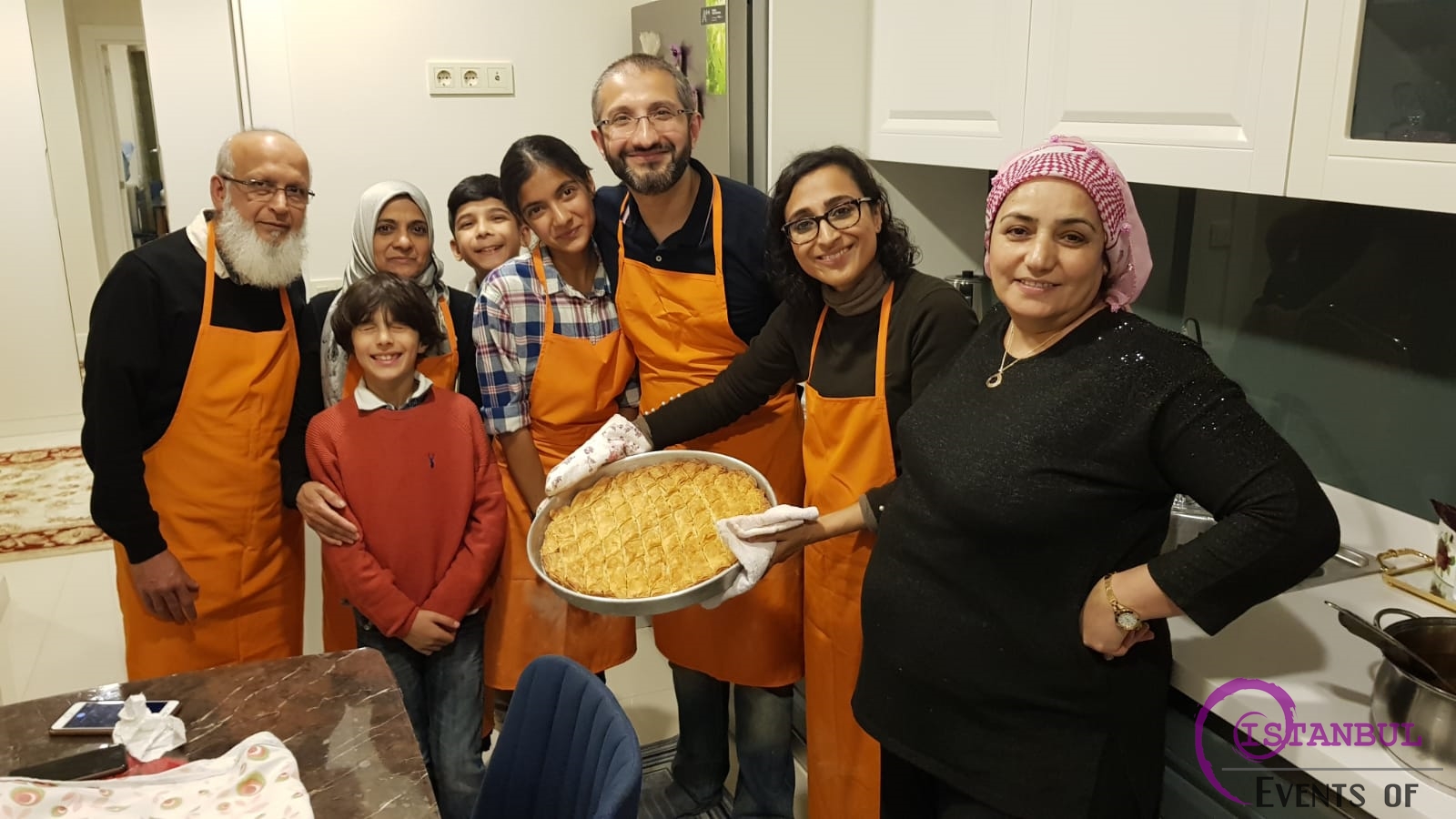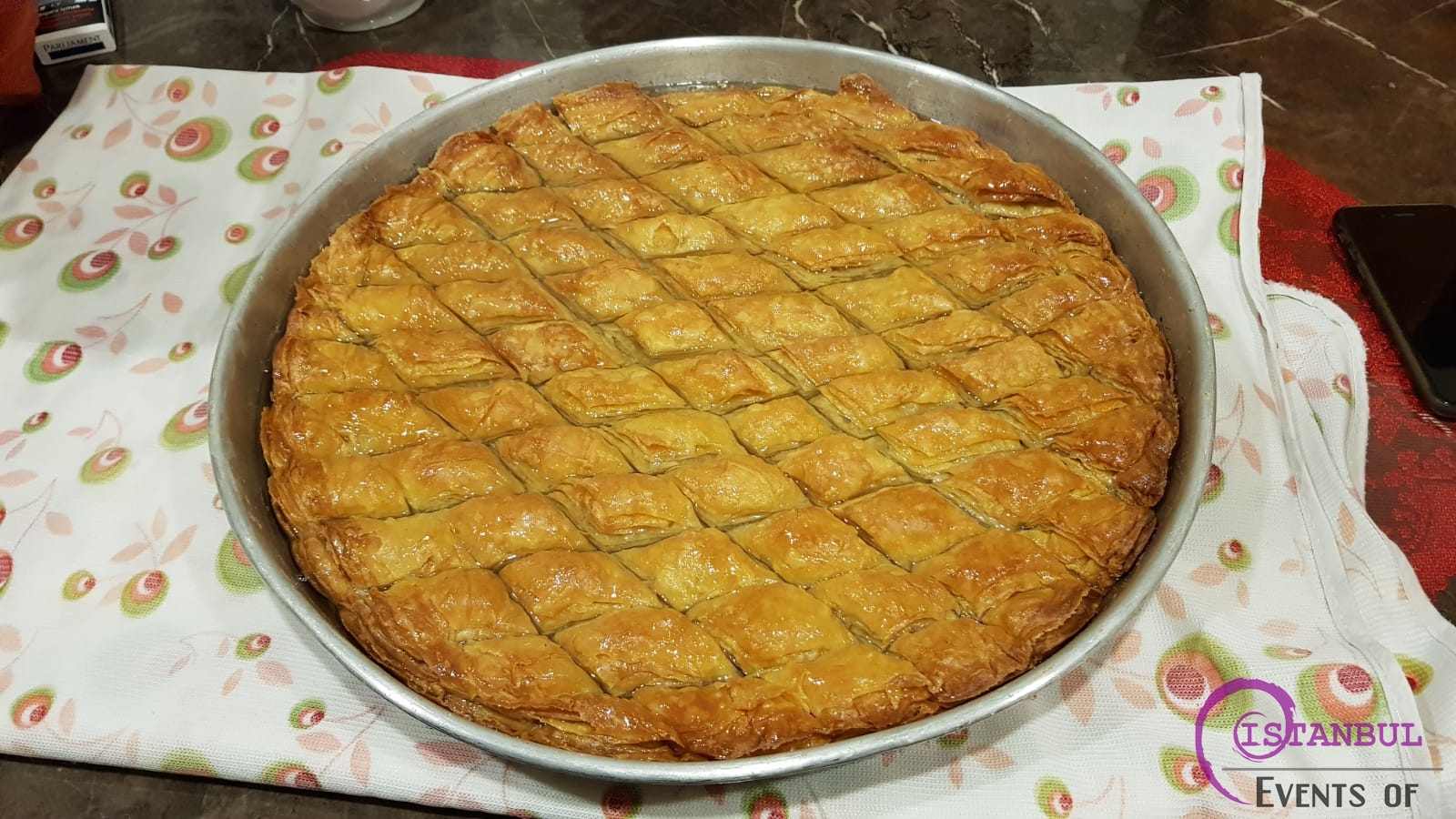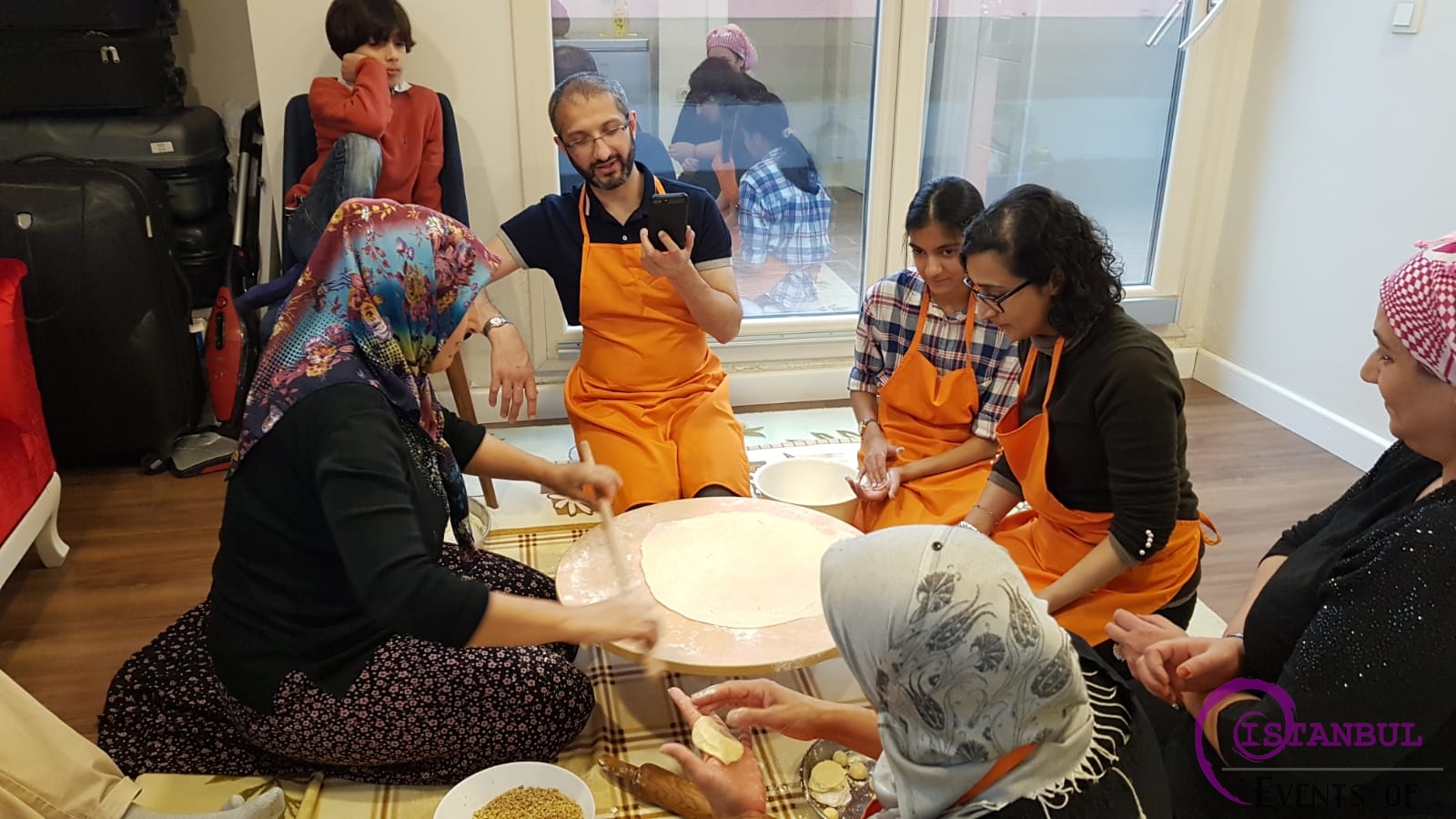Homemade Baklava and Turkish Sweets Workshop Istanbul
230,00 EUR
Homemade Baklava Course in Istanbul Available All Year Long
reservation.
Description
Homemade Baklava and Turkish Sweets Workshop Istanbul
- Duration: 3 hours
- Location: Meeting in Sultanahmet or from city center hotels / ISTANBUL
- Tour Language: Available in English and Turkish
Overview ;
Learn to make home made baklava from a localhousewife chef lady from her hands. This is the homemade baklava workshop for learning how to make Baklava from stratch. You will learn how to make make baklava, make dough, open the dough, give the shape, learn all the key points in how to make the Baklava. We will cook the baklava and you will learn all the stages of making the Perfect Baklava.
What you will see ;
We will pick you up from your hotel ( For Central City Hotels ) and take youa local Turkish house to meet and make baklava with our local Chef Ms. Azize near Sultaahmet. She will meet you and together with our chef, you will learn how to make Baklava. In the end of the workshop, we will eat the baklava that we prepared together along with Turkish Tea and Turkish Coffee. You can also take back home the baklava you prepared.
Apart From Baklava Lesson, upon request we can teach you all kinds of Turkish Ottoman Sweets & Pastries. Please ask us for Turkish workshops in istanbul.
Contact : Mr. Alp or Mr. Nurdogan ( Phone : +90 544 220 10 22 )
E-mail : info@eventsofistanbul.com
Homemade Baklava Workshop Starting Time ;
Time Schedule is flexible upon reservation.
What is Included ;
- Our Baklava Class is Hands on soo you will make the Baklava with our chef.
- Pickup and drop for city center hotels.
- Kitchen for the workshop.
- All Cooking Materials and All Ingridients.
- We will give you the written recipes as well.
- Turkish Baklava, Tea and Coffee tastings.
Meeting Point ;
We can pick you up from your hotels or flats ( For city center areas ) or start the tour from our culture center.
Here is our Address ;
Google Maps : https://goo.gl/maps/uXuyRmELZsx
Events of Istanbul – Les Arts Turcs Art Studio
Alemdar Mh. Incili Cavus St.
No: 19 Floor : 3 (Behind The Underground Cistern)
Sultanahmet 34110
Istanbul, Turkey
Contact : Mr. Alp or Mr. Nurdogan ( Phone : +90 544 220 10 22 )
E-mail : info@eventsofistanbul.com
Cancellation Policy ;
Here in this link you can find the details about our cancellation policy.
Additional Information ;
Turkish deserts
Baklava:
Baklava takes the first place in the list as the most renowned Turkish dessert. If you think you
have already tasted baklava, reconsider it. If you haven’t eaten baklava in one of the finest baklava produceries in Istanbul, where the Phylo layers are micrometer thick and the butter used is an extra refined one, you haven’t eaten baklava yet.
Kunefe:
Here comes another syrup bomb. What makes this one legendary is the Turkish treaded cheese, which starts to smelt within its finely weaved pastry encasing when the desert is cooked. The smelted mozarella-like cheese, which contrast the heavy syrup added later on with its slightly sweet flavor, adds up so much to the charm of the desert, also visually: The stretching cheese when you move a piece of this delicacy to your mouth, creates amazing scenes for food photography. This scene is even more mouth-watering should you be already familiar with the legendary taste of kunefe.
Muhallebi – Muhallabia:
If you are a first timer in Turkey, you could be prone to think that the typical Turkish desert has 90 percent sugar. Well, some of them like the previous two in the list are indeed syrup bombs. But there is also a considerable amount of light-weight Turkish deserts suitable for modern palate. Muhallabia, which is an Ottoman classic living today in the whole former Ottoman territory with dozens of tasty varieties, is one of them. The Turkish variety is an extra soft, blancmange-like creamy pudding with wonderful aromas like vanilla, orange peel or rose-water and with little sugar content. If you want to spice things up a little you can try this quite light pudding with some chocolate sauce as well.
Laz boregi:
Now that we have learnt about the two Ottoman classics baklava and muhallebi, it is time to learn about their yummy combination. Laz Boregi, like Turkish borek (hence the name boregi) or baklava is a layered pastry, but has a different filling than both borek and baklava: muhallabia. If you want to try the surprisingly good combination of baklava’s chrunchiness and muhallabia’s creameness you should aim for Black Sea restaurants..
Gullac:
Gullac like muhallabia is one of the light-weight Turkish deserts. Don’t get me wrong, light-weight stands no means for less tasty, quite the opposite actually: Gullac is such a playful combination of subtle aromas and flavors, that you might forget about every other Turkish delight once you taste it. Just imagine the arising rose scent while you enjoy a milky, nutty treat with extra thin layers of slightly sweet rice starch. The whole is usually topped with pomegranate pieces and ground pistachio. The killing touch..
Sutlac – Turkish rice pudding:
Well, the name is pretty self-explanatory, it is a milky rice pudding. It might sound ordinary. It can be also a quite ordinary pudding, but if you hit the right place where it is prepared more or less the traditional way, than you are going to find something else: A Casseroled desert with a burnt top sealing an almost fluid mixture of milk, rice and sugar trio. But can you imagine a Turkish desert without nuts? Hardly, right? Well, nuts come as a topping here. If a few spoonfuls of shredded hazelnuts are not enough for you can ask for one or two balls of vanilla ice cream to accompany them. Good luck waiting..
Tavuk Gogsü – Chicken breast:
Why would someone call a desert tavuk gogsu, or chicken breast? You probably don’t want it to be true, but yes, chicken breast is among the ingredients of this milky desert. It may not sound very appetizing, but believe me a little protein from the finely split chicken breast fibers adds up so much to the character of this extraordinary desert, that I can with confidence put this one to the top three of my favourite Turkish deserts..
Lokum – Turkish delight:
Who doesn’t know Turkish delight? This gelatinous cube, which is the precursor of jelly beans, is one of the best known Turkish deserts. If you think that it is a little too sugary for the modern-day palate, don’t buy the prepackaged ones, but good quality open Turkish delights prepared with a generous amount of nuts and honey as sweetener. Also remember, that this Ottoman invention, which’s Turkish name “lokum” is derived from the arabic expression “rahat ul hulkum” or “throat comfort”, was from the very beginning only meant as a treat consumed in small quantities. A few cubes of Turkish delight in a handkerchief was a popular gift among European high society in 19th century. And today it is customary to put one or two pieces of Turkish delight on the saucer when serving Turkish coffee.
Maras dondurmasi – Turkish ice cream:
Almost every introductory video of Istanbul feature an ice cream seller in traditional dresses. In some of them you see them also on action tricking the poor tourists which have a hard time trying to get hold of their ice cream cone on the one end of a stick reached over to them the ice cream seller. Thanks to the extra stickiness of the Turkish ice cream and quick reflexes of the seller grabbing what you paid for can be mission impossible. If you finally have your ice cream you should note that it is extra elastic beside being extra sticky and has a unique consistency and flavor thanks to the use of goat milk. If you are an ice-cream lover and open for new tastes, you should definitely take the challenge of grabbing a Turkish ice cream from the first traditional ice cream seller you stumble upon.
Asure – Noah’s pudding:
Here is the ingredients champ of all Turkish deserts. It is a mixture of all kind of grains, dried fruits and nuts bound a slightly gelatinous filling. The abundance of ingredients, which has a different mythological explanation in every religious culture, makes Noah’s pudding ideal for those who like it all mixed up..
Helva – halva:
Helva or halva is one of the names in this list which should sound familiar. After all the originally Arabic desert is present the same name in a multitude of cuisines throughout the world. The most common halva type is the one prepared with sesame oil. The few varieties of halva consumed in Turkey are also made from sesame oil. You can choose between plain, vanilla, kakao and pistachio versions. The Pistachio version with chunks of Turkish pistachio kernels is the most favored one. It is, however, a good idea to limit the consumption to thin slices as the sesame oil based treat is the most calorie-rich and heavy one among all the deserts in this list.
Irmik helvası- Semolina halva:
Well, I just told that halva is a sesame oil based sweet, but the name halva is also be used as a synonym for sweets in some cultures, as it was the case in the Ottoman cuisine. In Turkish cuisine, this former use survives in the name of semolina halva, for example, which being mainly a flour based home treat is quite different from the packaged regular halva. Beside Semolina, this desert features milk, butter, sugar and pine nuts. The cooking process turns the whole to a nut-butter like paste with a slightly gelatinous twist making semolina halva one of the most original flour based deserts in the Turkish cuisine. In Istanbul, this authentic taste can be found in some of the tradesman and home cooking restaurants(respectively esnaf lokantasi and ev lokantasi).
Kabak tatlisi- Pumpkin desert:
Here is another quite simple home desert which is also quite common in the self-service restaurants in Istanbul. It is prepared simply boiling pumpking pieces in water and adding sugar. Using milk instead of water adds an extra layer of flavor. favourite topping for pumpking desert is grounded walnuts.
Ayva talısı – Quince desert:
This list would be incomplete without a fruit desert on it. Our favorite is quince desert, which usually is served with the delicious manda kaymagi. The deep red color of the desert , when it is simmered the traditional way with its seed for several hours, stems from the coloring substances in the seeds, although nowadays most places take the short cut and use artificial coloring. Artificial or natural, the attractive color never disappoints you when you take the first bite, since the subtle flavor of the lightly sugared fruit is in perfect harmony with kaymak, chopped cream from the Anatolian water buffalo. Make sure to have an extra kaymak topping to make the tasting extra enjoyable…
History of Baklava
If you look for information on baklava on the Internet, you will face not only the Turks but the Middle East, the Eastern Mediterranean, and almost all the peoples of the Balkans. Greeks, Bulgarians, Armenians, Jews, Arabs, Baklava as their traditional sweet.
Considering that the Middle East, Eastern Mediterranean and the Balkans once constituted the Ottoman geographical area, it can be considered that baklava is regarded as an Ottoman dessert. But, because of the perception of “Ottoman” as “Turk”, this characterization is not welcomed especially Greeks and Arabs.
The Greeks claim that the Turks got the baklava from Byzantium. Professor Speros Vryonis, who is trying to prove this claim, writes that the likes of kopte or kopton (koptoplakous), very popular in Byzantium, look like a baklava.
According to American journalist Charles Perry, who argues that the baklava is not from Byzantium but from Central Asia, it is not a dough job like koplava or baklava, but a kind of confection. Among the two layers of beaten sesame and boiled honey are walnut, hazelnut, almond or poppy mixed with honey is done putting.
Sula Bozis, an Istanbulese Greek, refers to a Byzantine dessert named kopti, which is made putting a mixture of walnut, sesame and honey in the air between two thick yufka in a book about the culinary culture of the Istanbul Greek Cypriots. The recipes of this dessert were found in old food books from the Greeks.
If a confectionery, yufka-based paste work, which is a sesame paste based sweet, is turned into a dessert, then it may have turned into a multi-layered yufka based baklava. But it is also necessary to explain how yufkan entered the Byzantine culinary arts.
Professor Speros Vryonis says that the nomadic Turks find the culinary culture poor, telling them that the products they have obtained from their diet, the vegetables and fruits they find, and the simple sheet of bread and satiation of their bellies. Nomadic Turks could not make full bread because they did not use the oven; They are cooked on portable sheet and they are known as yufkıları bread. Today, even homemade bread dough cooked on a sac as in many regions of Turkey.
It can be accepted that the nomadic Turks who know the yufkayı basic food have formed layered pastry works putting various mortars between individually opened and cooked yufkas. It is also possible that they use sweeteners such as cream and honey as mortar and make multi-layered dough desserts. These are the roots of baklava.
Charles Perry sees Azerbaijan as a sign of evolution that allows the arrival of the classic baklava from the baked banana bread baked on the shabfire in the traditional sweet, Central Asian steppes known as Baklava. Baklava is a dessert made putting hazelnut peanuts between eight layers of loose grapes.
Pointing out that Azerbaijan is on the way of immigrants from Central Asia to Anatolia, Perry sees the baklava as a product of the contact of the nomadic Turks with the established Iranians in this region. “The baklava is like a mixture of baked potatoes in the Iranian tradition, pastries with pistachio nuts and multi-layered bread of the Turks,” he says.
Though it is an assumption, it comes closer than the claims of the Greeks.
Baklava in Ottoman
Whether in the roots of baklava, in ancient Greece, in Byzantium, or in traditions of nomadic period of Turks or Arabs, it is necessary to accept that the Ottoman period received a delicate and refined look that could be described as the classical baklava of today.
The oldest Ottoman record about baklava is the Topkapi Palace kitchen books belonging to Fatih period. According to this record, baklava was baked in Sarajevo during the satirical year 878 (1473). In the middle of the 17th century, Evliya Çelebi, who was a guest of the Bitlis Bey’s house far from Istanbul, wrote that he had baklava. It is written that in the “Surname” of the Vehbi, which describes the grand wedding of Sultan Ahmed ‘s four sons in 1720, all guests were given baklava.
From these records, it is understood that in almost every region of the Ottoman Empire, the known bean paste is consumed mostly in the palace, in the houses, in the banquets, in the festivals.
It can be said that the effort to please the hard-boiled wealth and position holders has turned baklava from a simple pastry business into a sophisticated kitchenware that requires mastery.
Some researchers, such as Bert Fragner from the University of Bamberg, note that the eating and drinking tendencies in the Ottoman Empire were shaped the taste and preferences of the Istanbul society.







